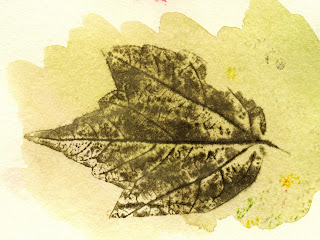When I wrote my first piece on leaf printing, I received some wonderful feedback from others on their particular approaches. Although I haven’t had time to try them all out (yet), I did experiment with pressed maple leaves, watercolors, and household detergent. Since I have allergies and a low tolerance for fragrances, I used Free and Clear Dish Soap by Seventh Generation – but I imagine almost any detergent will do.
First, I created some watercolor washes on various scraps of watercolor paper, and let them dry thoroughly. Next, I mixed up some puddles of very saturated watercolor paint on my palette, and added a drop or two of soap, mixing well. The amount of paint saturation will depend on how dark or light the print will be.
Then I painted the back of my leaf with an even coat and carefully turned it over, pressed it gently onto my watercolor paper, trying not to move it once it had contact. I covered it with a paper towel and a light piece of cardboard and pressed, removing the cardboard, paper towel, and leaf after about 30 seconds. After a few practice leaves, you can adjust materials and technique to get the look you want.

Interestingly, leaf printing features in US history. Benjamin Franklin investigated leaf printing as a way to foil counterfeiters, developing a system of creating metal casts from leaves to incorporate into the currency printing plates.
Contact leaf printing and variations of impressing printing plates from natural material was also developed by Philadelphia naturalist Joseph Breintnall and Austrian printer Alois Auer to illustrate complex botanical specimens.
Leaf printing is a great way to record complex veining and a helpful learning tool, but also an easy and fun way to create leaf images for journals or to decorate wrapping paper. It’s a new way to experience the leaves beneath our feet, as we discover lines and structures we may not noticed before.
A big thank you to Pam Johnson Brickell for suggesting the dish soap as a way to help the paint stick to the leaves. Thanks, Pam!
You can visit my Flickr Leaf Print Set to see these images larger and to see other experiments in leaf printing.




Interesting leaf prints. The soap is a good idea, too--I would guess it would make the mixture a little thicker which would help it show up better.
ReplyDeleteOh my, I'm finally getting a chance to read this great post and here I'm mentioned! Thank you! Glad the tip worked out. Great info about the history!
ReplyDeleteVery cool! The last time we tried leaf printing it didn't work out very well.
ReplyDeleteHi Kathy, the soap does thicken up the watercolor paint a bit which gives it some body. It can also add a bit of interesting texture.
ReplyDeleteHello Pam! If I were more organized I would have given you a shout - glad you found it so soon. The history part was fascinating to me, too.
Hi Jen, and thanks for visiting. Sometimes the leaves just don't print well for whatever reason. I've found that pressing them a bit helps, and choosing leaves with well-defined edges and veins works better. Print on the back of most leaves for stronger definition, and plan to experiment! Good luck with your next round of leaf printing!
Soap!!! I just read this (busy season) and am now itching to try this. Your results are inspiring.
ReplyDelete